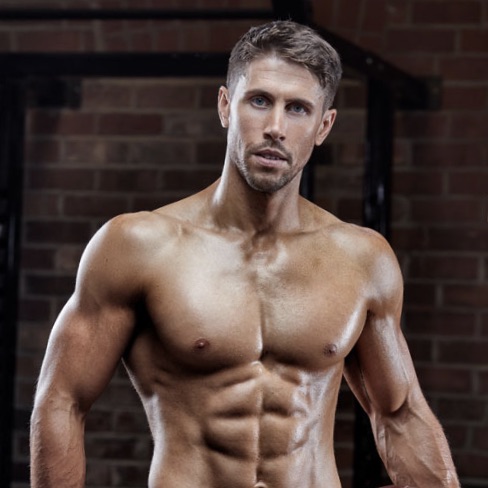Most of us want a more defined mid-section. As far back as the ancient Greeks, statues of god-like men with literally chiselled out abs were the ultimate show of athleticism, health and virility. Imagine in another 2000 year’s what statues representing todays modern man might look like!? Slightly overweight and sat at a desk maybe. Either way not very god-like….All the way back to Hercules, up to modern day Superheroes like Superman and Batman, it’s engrained as part of our culture, part of our psyche, and even part of our subconscious mind. Good abs are a sign of strength, health, fitness and good genetics. Everybody wants them, but nobody knows what it takes to turn a modern-day beer keg belly in to a six pack. Here’s what you need to know.
What you think is right, is wrong
When most men start their journey to achieve that elusive six-pack, it’s usually looks something like this:
- Begin stripping down fat with extra Cardio, lots of it.
- Add in heaps of crunches, sit-ups, planks and other high rep bodyweight moves you might ‘feel’ are working your abs (chasing the burn).
- Maybe even a “six pack in six weeks challenge” from some magazine or generic training App.
Doing these things will get you a few steps closer to your destination, but none of it will ever take you the full way. That’s why so many of us stop after a point, having never actually hit our six-pack target. We’ve been doing what we think is right, progressed so far but now it’s got to the point where we start blaming things like our genetics. Or whatever other lame excuse we might come up with at the time.
And who would blame you? You’ve worked hard, you’ve spent the time and energy and not got to your destination.

Here’s what you should be doing instead
Accept responsibility and stop blaming your genetics, it’s all on you and the actions you take. The more time you spend directing your energy in the right places the more likely you are to achieve your end goal.
Now we’re not going to go in to specifics here, and what your program should look like, because everyone’s different. If you want targeted specifics and accountability, then hire a good COACH. But here are the key components that are ESSENTIAL to having some six-pack success.
Are you including these key components?
Component 1…..
YOU NEED A Resistance training program that targets the entire body, with special attention to large muscle groups. Nothing burns fat better than muscle, so developing a little extra muscle in all the right places allows you to not only drop body fat fast, but having that complete athletic look. This may sound obvious to some but for others the key component missing in their six-pack program.
THIS MEANS You should have a sound resistance training program. The program should be set at the right level for your own abilities and limitations, but also working towards being able to lift progressively heavier weights in key movements. Such movements would include: heavy vertical and horizontal presses, rows and pull-ups/chin-ups, and appropriate squatting and hip-hinging movements (deadlift variations, back extensions, glute bridges, hip thrusts etc.).
[click_to_tweet tweet=”Progressive overload is key: Add weights. Get Stronger. Repeat.” quote=”Progressive overload is key: Add weights. Get Stronger. Repeat.” theme=”style3″]
Component 2…..
YOU NEED A sound nutrition plan that places you in to a slight calorie deficit. Who ever said that abs are made in the kitchen, are wrong, and clearly don’t know what a kitchen looks like…. Abs aren’t made in the kitchen unless your kitchen doubles up as a gym! Abs are built using a good overall resistance programme, and targeted progressive abs training (component 3 below). But, your nutrition and food choices will be the difference between seeing those abs you’ve built, or keeping them hidden away for good underneath a layer of body fat.
[click_to_tweet tweet=”Who ever said that abs are made in the kitchen, are wrong, and clearly don’t know what a kitchen looks like…. Abs aren’t made in the kitchen unless your kitchen doubles up as a gym! #abs #coretraining” quote=”‘Abs aren’t made in the kitchen unless your kitchen doubles up as a gym!'” theme=”style3″]
THIS MEANS Depending on body type, activity levels and preferences everyone will have a slightly different diet that would be considered ‘optimal’. But you should look to increase the overall quality of your nutrition, paying special attention to your protein sources, fibrous vegetables, adding in good fat sources, and nutrient dense foods such as berries and leafy greens. You then need to create a slight calorie deficit. If you don’t know how to do this or have PROFESSIONAL HELP, then apps like MyFitnessPal or good BOOKS can guide you through this.
Component 3…..
YOU NEED Targeted and progressive abs training. Unless you’re a complete beginner, or you’re trying to develop muscular endurance, you need to be using weight. Just like any other muscle group the abdominals respond to being challenged. Force them to take shape, and develop deep etched lines by including some form of progressive overload in to your abs workouts. A few sets of crunches, sit-ups or planks at the end of a workout aren’t going to cut it.
THIS MEANS You need to be including loaded abs exercises in to your routine. Exercises like some of those shown below that can progressively overload the abdominals in all its functions (flexion, rotation, pelvic tilt, and resisting of these movements). Include at least two exercises (3-4 sets on each), on 2-3 days each week. These are just some examples, note the use of some form of resistance with each of these.
Component 4…..
YOU NEED Cardio. Yes, many people get by without doing much cardio, if any at all. But these are not your average person. Genetics, drugs, lifestyle factors all play a part in the success of these people. But for 99% of us, adding in a few heart pumping efforts every week will get us closer to our end goal.
THIS MEANS Whether you choose to do steady-state cardio or shorter interval style workouts are up to you. Short distance can be more muscle ‘sparing’ and gives you more for less time. But not ideal for those on low carbohydrate diets. Conversely longer duration efforts, albeit slower and more time-consuming use a higher percentage of fat as a fuel source, so theoretically better at burning fat. But can also eat away at muscle tissue and switch off some essential muscle growth mechanisms. Cardio is not black or white, “this is right, and this is wrong”, it depends on the situation, dietary factors, and what you’re most likely to be motivated to do. Just pick a method and go with it. Cardio helps to create that calorie deficit you need, so as a rule of thumb you can get away with less cardio, say 2 workouts a week, if you’re in a big calorie deficit through your diet. If you prefer to eat more food however, you may consider doing a little more cardio to compensate. Do more cardio, or eat less calories, that’s your choice.
Ask yourself these questions
By knowing these simple yet essential components, you should now be able to identify which of them you need to be focusing on more.
If each component already plays a role in your current approach, you may wish to consider which of these you could be doing better.
Finally, if you want to make impacting steps towards a more trimmed mid-section always be asking yourself these questions:
- Is my resistance training program working for me, and what could I do better?
- Is my diet consistent, and am I getting in all the nutrients and fuel my body needs?
- Am I maintaining a slight calorie deficit? Am I ruining it at the weekend??
- Am I including direct abs training in to my program? Progressively overloading them using at least two exercises (3-4 sets on each), on 2-3 days each week.
- Am I doing some form of cardio EVERY week?

I build Olympians, Cover Models and those who want to look like them. Author or “Ultimate Abs” available in all good book stores.
